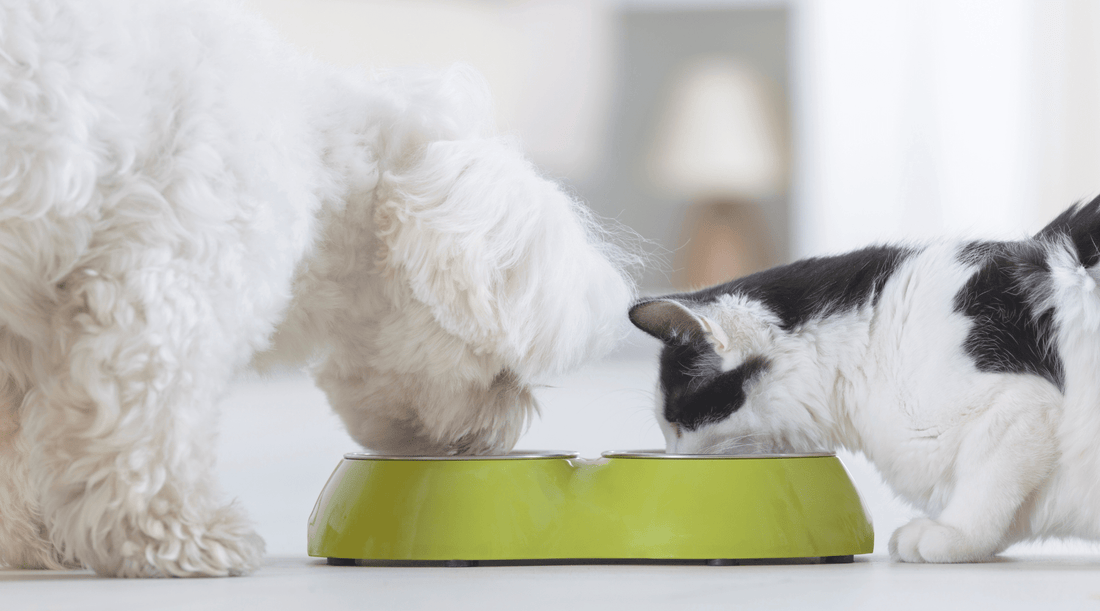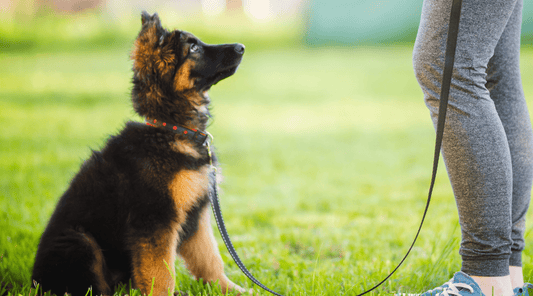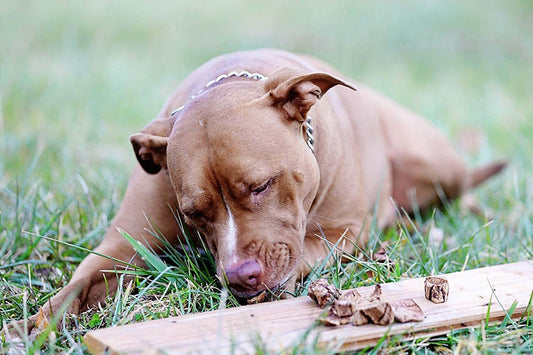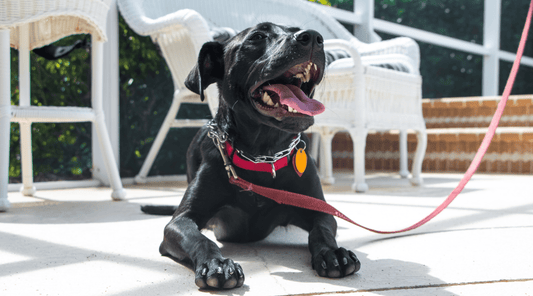
Can Dogs Eat Cat Food? And Why Bruno Is Convinced He’s a Cat Now
Dawn Miller Apr 14, 20254 Minute ReadLast weekend, I was helping Mrs. Jenkins mulch her backyard rose garden. She’s got the most beautiful roses in the neighborhood and somehow never gets overrun by weeds. Although the occasional thorn will get you if you're not careful.
Naturally, I brought Pixie and Bruno along. They love sniffing through her flower beds and harassing the squirrels who occasionally steal birdseed from her feeders.
Everything was going great until I noticed Bruno with his head stuck in Mrs. Jenkins’ cat dish. Apparently, while we were admiring her roses, Bruno had followed Mrs. Jenkins’ tabby, Oscar, right into the kitchen. And let’s just say, he didn’t stop at a polite sniff.
“Can dogs eat cat food?” Mrs. Jenkins asked, looking mildly horrified.
“Good question,” I laughed. “Don't think it will kill him. But I’m guessing that wasn’t his best lunch choice.”
Spoiler alert: It wasn’t. Here’s why.
Is Cat Food Bad for Dogs?
Cat food is nutritious for cats. But for a dog... not so much. Cats have very different nutritional needs from dogs.
Dogs are well-known for being opportunistic eaters. In the wild, dogs learn to eat just about anything to survive. So, while they'd prefer a meaty mammoth dog bone, they'll take some days-old garbage.
This isn't a swing at dog intelligence. It's about survival. It's instinct.
Of course, Oscar's food isn't garbage. It's perfect for his feline body. Here's why.
Too High Protein
Cats are primarily carnivores, while dogs are more like humans—omnivores that lean toward scavengers. That means cats need more protein than dogs.
High-quality cat food is usually around 23%-25% and really should be higher. Dog food is closer to 18%.
Doesn't sound like a big difference. But in the intricate balance of things, that's significant.
And here's the thing. If it were just too much protein, that probably wouldn't be so bad. It's what it lacks that's the biggest problem.
Fiber
Dogs need more fiber than cats for healthy digestion. While cats can get away with eating some grass or catnip now and again, in the wild, dogs love foods like squash, pumpkin, peanuts, green beans, berries, carrots, sweet potatoes, and apples when they can get them.
Cats will turn their noses up at these foods, except for cantaloupe. Fun fact! Cats love cantaloupe because it smells like meat to them. That's sneaky cantaloupe trying to get cats to spread its seeds.
Anyway, cat food often lacks the fiber content dogs require.
Fats and Calories
Cat food tends to be richer in fats, particularly saturated fat, which can lead to weight gain and upset stomachs for dogs in these amounts.
Ounce for ounce, cat food is more calorie-dense than dog food. It's too easy for a dog to overindulge, not realizing how much they just ate.
Amino Acids
All protein is not the same. Amino acids are the building blocks of protein, and depending on the ones present, they make different kinds of protein, such as muscle and collagen (structural).
Dogs and cats have slightly different amino acid needs because they can each build certain ones internally. Cats need more taurine and arginine because they can't make them, while dogs need more histidine, isoleucine, leucine, and tryptophan, among others.
Missing Nutrients
Dog food often includes ingredients designed to support joint health, coat health, and overall well-being.
Cat food? Not so much. It's optimized for cats who need more hairball control and bladder support.
Can Dogs Eat Cat Food Regularly?
The occasional indulgence probably isn't going to make or break their diet. Although cat food is around 3 times more expensive ounce for ounce because of different dietary needs. So, it could break your budget.
There are many better ways to ensure your dog is eating enough protein—and with the right amino acid ratios.
Bruno’s love affair with Oscar’s food wasn’t the first time I’d caught him sneaking snacks from places he shouldn’t. And it turns out, he’s not the only dog in the neighborhood with a cat-food addiction. Ms. Jenkins had recently had to move Oscar's bowl inside because the occasional escaped dog was helping itself.
Can Cat Food Make Dogs Sick?
Yes, it can. Here are some of the dangers.
- Weight Gain. The extra calories in calorie-dense cat food can lead to obesity, especially in less active dogs.
- Pancreatitis. The high-fat content can put stress on the pancreas, causing inflammation.
- Nutritional Imbalance. Dogs need a balanced diet with nutrients specifically formulated for them. Cat food lacks these essential nutrients.
- Gastrointestinal Upset. Vomiting, diarrhea, and general stomach upset can occur if a dog consumes too much cat food. Bruno found this out the hard way!
So, if you’re wondering, “Is cat food bad for dogs?”, the short answer is yes. Bruno’s stomach can vouch for that.
While dogs are drawn to that extra protein in cat food, it's not really what their bodies need. If you have a cat, they may even refuse to eat their own food because let's be honest...high protein is appetizing to us omnivores (humans) even if we should eat a salad more often. Dogs face the same dietary conundrum.
If you have cats and dogs, this could become a daily battle. But I've got a suggestion.
What to Feed Picky Dogs Instead
Okay, so if dogs shouldn’t eat cat food, what can you give them to feed that desire for a higher-protein food?
Dogs may eat cat food because they enjoy the:
- Meaty smell
- Added texture
- Meaty flavor
- They may actually be lacking extra protein.
So it's time to look for dog treats that give dogs these sensations and dog health benefits without the downsides.
Healthy, Dog-Friendly Options:
- Single-Ingredient Treats. Give them beef lung bites. These organ meat treats are natural, high-protein, and—most importantly—safe for dogs.
- Feed Their Food Texture Needs. Dogs chew on dog bones because of instinct. Chewing action entertains them, cleans their teeth, alleviates boredom, and can stop destructive chewing. So give your dog a meaty beef dog bone every once in a while. The bone marrow in grass-fed beef bones is high-protein and may be even more delicious than cat food.
- Protein-Packed Snacks. Most dogs need more than 18% protein. But it should come from low-calorie source like beef lung dog treats or grass fed beef dog bones.
- Extra Joint Support. Dogs have undergone much more significant breeding than cats. This has led to many breeds having joint issues. From middle age on, all dogs need joint supplements like all-natural beef trachea tubes.
- Nutrient-Rich Food. Make sure your dog’s meals contain the right balance of protein, fat, carbohydrates, vitamins, and minerals. Did you know you can refill dog bones with fiber-rich foods like blueberries, apples, and pumpkin for more fiber?
- Crunchy Chews. Things like beef bones help with mental stimulation and dental health. They’re a win-win.
How to Train a Dog Not to Eat Cat Food
Once you've chosen high-protein dog treats with no added sugar or strange ingredients, it's time to talk training. The dog commands you need here are either "leave it" (if they're approaching the cat bowl) or "drop it" (if they already have a mouthful).
To find out how to teach your dog these commands and more in just 7 days, check out the 7-Day Dog Training Challenge.
👉 Join here
Available On:


Disclosure: This article may contain affiliate links, which means we may earn a small commission if you make a purchase through these links—at no extra cost to you. We only recommend products we trust and believe will benefit you and your K9.



